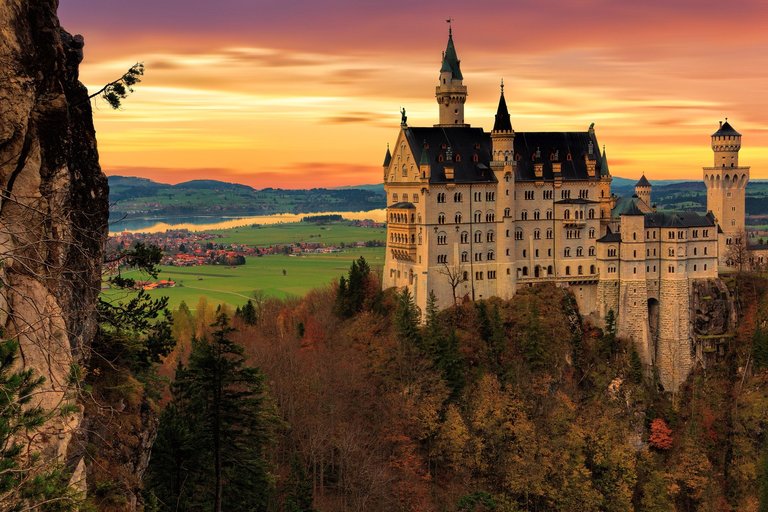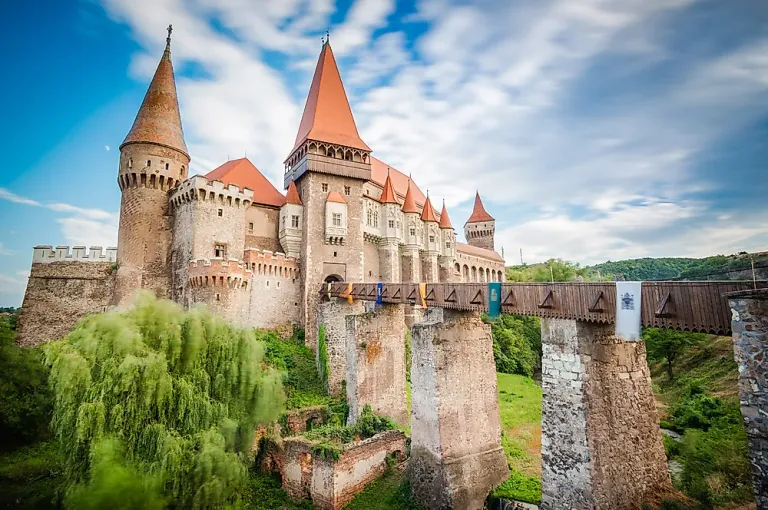About Castles and Medieval Royalty

Did medieval royalty prefer to live in castles or was it mostly for defensive purposes? I asked historians out of curiosity, let's see.
Part of the reason castles don’t come off as fancy is because we’re usually looking at the stripped carcasses. The plasterwork and tapestries that covered the walls are gone; so are the patterned floors. It still would be a big change from what we’re used to, but it’s like looking at a house with unfinished drywall and exposed plywood floors and wondering how anyone could live like that.
In Avignon France, the old temporary Vatican has a VR tour where you can "see" how it looked when it was occupied.
Today's castles are often ruins and reconstructions; to see how rich the rooms were with warm tapestries on the walls, rugs and furniture in the rooms makes them remarkably inviting. Add a roaring fire, good food and protection from the elements and you might be tempted to stay.
Through the middle ages castles began to be built more and more with prestige and grandeur in mind rather than defensive qualities per se, although this does depend where in Europe you are exactly. In the UK for example castles still had a dual purpose e.g. Raglan castle, which had to defend the marcher lords against the Welsh and entertain European royalty
I'm no expert, but on a recent trip to Germany, a tour guide gave some interesting food for thought that made sense: in a large, 40+ room castle, the average number of inhabitants was... about 12 people (6 family members, and roughly one servant each). The reason being that castles at the time weren't palaces; they were specifically meant for the whole village below to be able to come up inside and withstand a passing army. When that wasn't happening, a king would actually want as few people as possible up in the castle, because they'd actually be making money and producing goods if they were down in the village.
The mix of both medieval times was a very uncertain and unruly part of history, so the rich wishing to live in defensive and fortified positions makes sense. However, you also can't deny it was a status symbol and to some extent in "vogue" . Obviously, as things settled down you saw a switch to things like palaces and manor homes for the wealthy.
Medieval castles originated in Europe after the end of the Carolingian Empire.
When Charles the Fat inherited Aquitaine from his cousin he became ruler of a vast empire that was already unstable due to internal power struggles, years of mismanagement and brutal Viking raids across most coastal cities and even Paris. Charles was a sick man and unable to defend his territories he made a deal to give lands to Viking warriors to rule in exchange for their help against other raiders who would attack the empire. However, this deal with pagans undermined his rule and he eventually left Paris and died shortly after, leaving his empire kingless and in confusion.
The territories of the Carolingian Empire were divided among lords, nobles, local rulers and commanders and now for the first time these local powers had much more authority and autonomy than before and could exercise tax collection, defense duties, local administration, wage war, etc much more freely than before. The Middle Ages were a time of political instability, migrations and many conflicts so it became imperative for local rulers to be able to have defenses. With a less centralised power structure, these rulers needed to defend against viking raids themselves and thus castles became a way to have a stronghold in the region(s) they ruled which was fortified and located in strategic positions.
It was not uncommon however for lords to have other properties in important towns, summer houses, hunting lodges, etc. However, their main residence was the one where they would be safe and where they would be able to store their gold, food supplies, families, etc. The city of The Hague in the Netherlands, for example, evolved around a hunting lodge/property of the counts of Holland in the 12th century.
So castles were not always moldy, dark and cold. They were generally owned and built by wealthy people who would hire specialised workers to design furniture and rooms to make for a nice accommodation. Many castles also started as a single structure (such as a tower, for example) which was many times made at least partially of timber, and were slowly improved throughout centuries of use by different owners.
When the owners couldn't afford the resources to keep the castle in good condition, they would often sell it to another lord or even abandon the property. I doubt they would live in a castle when it already decayed to the point of being humid, cold and moldy inside. Imagine you have a huge mansion, why would you stay there when you can't afford the up keep costs if you can sell the place and get a smaller place somewhere else? The Carew Castle in England is a good example. Another common reason for abandoning a castle was damage by fire which would often turn out to be too expensive to repair.
I am not a historian but I've been reading about the period lately and wanting to live in a castle… So I hope it helped those who are curious too.

Nice photo
Congratulations @moriame! You have completed the following achievement on the Hive blockchain And have been rewarded with New badge(s)
Your next target is to reach 70 posts.
Your next target is to reach 100 replies.
You can view your badges on your board and compare yourself to others in the Ranking
If you no longer want to receive notifications, reply to this comment with the word
STOP